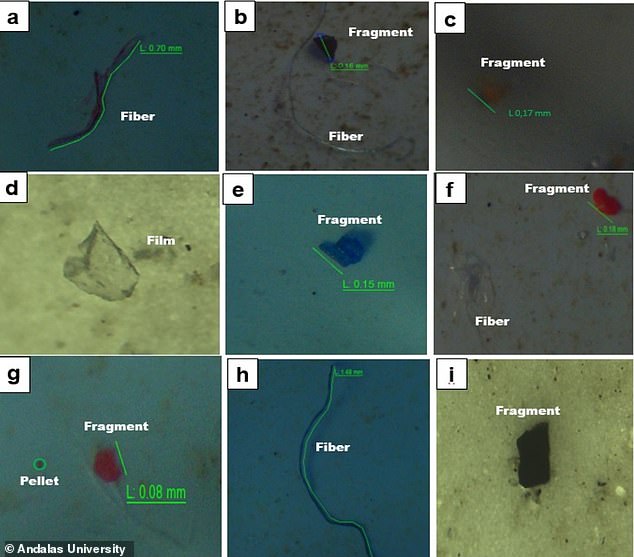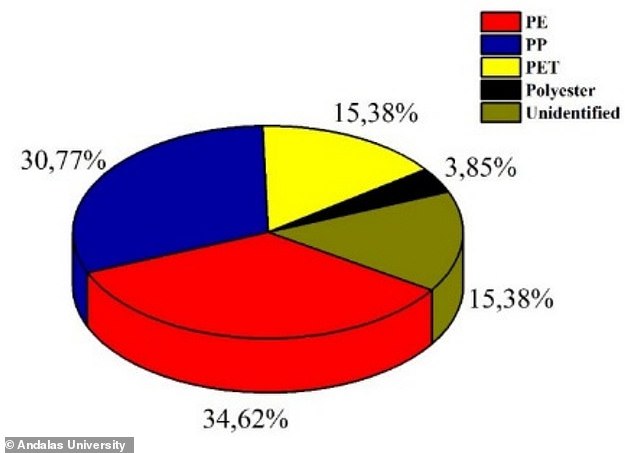Now carcinogenic microplastics are found in TABLE SALT
The harmless table salt you add to your meals combines with microplastics, according to a study that comes a week after bottled water was found to be full of toxins.
Researchers from Indonesia’s Andalas University examined 21 brands of table salt and found that each brand contained small pieces of plastic, fibers, films and pellets.
The molecules have been linked to the development of cancer, heart disease and dementia, as well as fertility problems.
Research shows that the harmless table salt that you add to your meals combines with microplastics
The team detected up to 33 particles per kilogram, meaning people consume more than 1,000 microplastics every year.
The recommended intake of table salt for Americans is about seven grams per day.
Microplastics are pieces of plastic that are smaller than five millimeters. Most come from single-use plastics, such as bottles and food packaging, which break down slowly.
Research shows that microplastics are everywhere – even in the snow at the top of Mount Everest – but scientists are most concerned about microplastics in food, water and the air around us.
“Salt can be contaminated by water taken from the sea to make the salt, which can contain microplastics, organic matter and sand particles, as well as during its production,” the new study published in Global Journal of Environmental Science and Management.
The study was conducted using popular table salt brands purchased in Indonesia.
However, according to the global export data company, the country exports most of its sea salt to the US, Singapore and the Czech Republic Sat.
The team checked to see if table salt used by most people around the world was contaminated with the small plastics and purchased 21 brands from markets and supermarkets.

Researchers from Indonesia’s Andalas University examined 21 brands of table salt and found that each brand contained small pieces of plastic, fibers, films and pellets.
Researchers did not share the brand names “to maintain privacy” they shared in the study.
Microplastic extraction was performed by weighing 50 grams of salt from each package and then combining it with water to remove organic impurities.
The remaining samples, housed in a flask, were placed on a hot plate and stirred at 300 revolutions per minute for 30 minutes at 149 degrees Fahrenheit.
The sample was cooled to room temperature and stirred at 300 rpm until the salt was completely dissolved.
The team then looked at what was left in the flasks with a microscope and identified four types of microplastics based on shape, size and color.
‘This study successfully identified four different forms of microplastics in all 21 salt samples, of which fragments were the most common (67.49 percent), followed by fibers (23.82 percent), films (6.08 percent) and pellets (2. 61 percent). secondary components,” the study reads.

The study also identified four types of polymers: polyethylene (34.62 percent), polypropylene (30.77 percent), polyethylene terephthalate (15.38 percent) and polyester (3.85 percent).
‘The morphologies of microplastics show variations between different salt brands.’
The team found that the tiny particles looked black, blue, yellow, red and transparent – black was the most dominant color.
The study also identified four types of polymers: polyethylene (34.62 percent), polypropylene (30.77 percent), polyethylene terephthalate (15.38 percent) and polyester (3.85 percent).
Polyethylene (PE) is a synthetic resin and polypropylene (PP) is a robust, heat-resistant plastic.
Polyethylene terephthalate (PET) is used in clothing fibers and containers for liquids and food, and polyester is a man-made fiber material.
The US also imports salt from Spain, which also turned out to contain microplastics.
A study conducted by the University of Alicante in 2017 found that there are up to 280 molecules per kilogram of salt from the European country.
